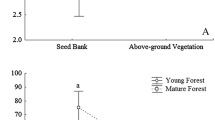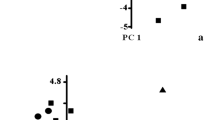Abstract—
The boxelder (ash-leaved) maple has widely been used in Russian forestry and settlement landscaping. However, it is now recognized as one of the most aggressive, invasive tree species because of the high survival level of its self-seeding offspring. In many regions, it is listed in local Black Books of Flora. Long-term monitoring of the state, development, and death of the spontaneously rooting maple specimens has revealed the degree of ecological compliance of this species with various habitat conditions. It is demonstrated that the self-sown maple intrudes into vacated areas of natural and artificial forest ecosystems in a short time (within the life cycle of plantations), e.g., after the death of a forest-forming species, thinning, and recreational compaction of soils. In treeless areas receiving the optimal water supply, it settles in disturbed lands, even on barren soils. For example, it is rather common in private gardens, city squares, and recesses along transport routes. Such a “nomadic” strategy allows it to occupy more and more habitats. It is important that seed-originated trees disappear completely in 20–35 years due to their inadequate competitiveness for moisture and light with native species of trees, shrubs, and grasses. Although its introduction lasts for a century, this adventive species could not fully naturalize and find its ecological niche in Russia. Nevertheless, its use as a planting material in floodplain, forest-growth conditions and in settlement landscaping should be restricted.

Similar content being viewed by others
REFERENCES
Agrolesomelioratsiya (Agricultural Forestation), Sus, N.I., Ed., Moscow: Kolos, 1966.
Baginskii, V.F. and Kudin, M.V., Forestation processes in the placed resettled after the Chernobyl accident, Lesn. Taksatsiya Lesoustroistvo., 2009, no. 1 (41), pp. 12–17.
Bespalova, A.E., Natural renewal of ash-leaf maple and other tree species in the forest belts of the Kalmyk ASSR, in Povyshenie ustoichivosti zashchitnykh nasazhdenii v polupustyne (Increase of Resistance of Protective Plantations in Semidesert), Moscow: Nauka, 1981, pp. 160–172.
Biologicheskie invazii v vodnykh i nazemnykh ekosistemakh (Biological Invasions in Aquatic and Terrestrial Ecosystems), Moscow: KMK, 2004.
Campagnaro, T., Brundu, G., and Sitzia, T., Five major invasive alien tree species in European Union forest habitat types of the Alpine and continental biogeographical regions, J. Nat. Conserv., 2018, vol. 43, pp. 227–238.
Dgebuadze, Yu.Yu., Invasions of alien species in Holarctic: some results and perspective of investigations, Russ. J. Biol. Invasions, 2014, vol. 5, no. 2, pp. 61–64.
Dudkin, E.A. and Ivanov, A.I., Biological invasions in ecosystems of the Sura and Khoper River floodplains in Penza oblast, XXI Vek: Itogi Proshlogo Probl. Nastoyashchego Plyus, 2014, no. 5 (21), pp. 71–77.
Emelyanov, A.V., Frolova, S.V. Ash-leaf maple (Acer negundo L.) in coastal phytocenoses of the Vorona River, Russ. J. Biol. Invasions, 2011, vol. 2, nos. 2–3, pp. 161–163.
Erfmeier, A., Boehnke, M., and Bruelheide, H., Secondary invasion of Acer negundo: the role of phenotypic responses versus local adaptation, Biol. Invasions, 2011, vol. 13, no. 7, pp. 1599–1614.
Firsov, G.A. and Byalt, V.V., Review of woody exotic species producing self-seeding in St. Petersburg (Russia), Russ. J. Biol. Invasions, 2016, vol. 7, no. 1, pp. 84–104.
Grigor’evskaya, A.Y., Lepeshkina, L.A., Vladimirov, D.R., and Sergeev, D.Yu., The creation of a black book for Voronezh oblast, Russ. J. Biol. Invasions, 2013, vol. 4, no. 2, pp. 120–132.
Kamyshev, N.S., The state and dynamics of weediness of the fields of the Kamennaya Steppe, Tr. Voronezh. Gos. Univ., 1959, vol. 56, no. 1, pp. 17–30.
Kling, A.P., Gaivas, A.A., and Kumpan, V.N., Combat measures with ash-leaf maple in gardens and parks in Western Siberia, Plodovod. Yagodovod. Ross., 2014, vol. 39, pp. 105–109.
Koltunova, A.I. and Kuz’min, N.I., Ash-leaf maple (Acer negundo L.) in Orenburg region, Izv. Orenb. Gos. Agrar. Univ., 2017, no. 5 (67), pp. 211–213.
Kostina, M.V., Minkova, N.O., and Yasinskaya, O.I., Some biological features of Acer negundo L. in green plantations of Moscow, Russ. J. Biol. Invasions, 2014, vol. 5, no. 1, pp. 21–28.
Kozhevnikov, A.V., Weed and adventive flora of the Moscow Botanical Garden, Byull. Mosk. O-va. Ispyt. Prir., Otd. Biol., 1935, vol. 44, no. 4, pp. 193–203.
Leont’ev, D.F. and Zvereva, K.A., Invasion of ash-leaf maple and sea buckthorn along the Moscow tract in the Irkutsk–Angarsk section, Byull. Nauki Prakt., 2016, no. 11 (12), pp. 40–44.
Lesnaya entsiklopediya (Forest Encyclopedia), Moscow: Sovetskaya Entsiklopediya, 1985, vol. 1.
Mayer, K., Haeuser, E., Dawson, W., Essl, F., Kreft, H., Pergl, J., Pyšek, P., Weigelt, P., Winter, M., Lenzner, B., and van Kleunen, M., Naturalization of ornamental plant species in public green spaces and private gardens, Biol. Invasions, 2017, vol. 19, no. 12, pp. 3613–3627.
Mędrzycki, P. and Pabjanek, P., Linking land use and invading species features: a case study of Acer negundo in Bialowieza village (NE Poland), in Plant Invasions Species Ecology and Ecosystem Management, Leiden: Backhuys, 2001, pp. 123–132.
Merceron, N., Lamarque, L., Delzon, S., and Porté, A., Killing it softly: girdling as an efficient eco-friendly method to locally remove invasive Acer negundo, Ecol. Restor., 2016, vol. 34, no. 4, pp. 297–305.
Nikitin, S.A., Forest growing conditions in the lower reaches of the Ural River, Tr. Inst. Lesa, Akad. Nauk SSSR, 1957, vol. 34, pp. 7–27.
Saccone, P., Brun, J.-J., and Michalet, R., Challenging growth-survival trade-off: a key for Acer negundo invasion in European floodplains? Can. J. For. Res., 2010, vol. 40, no. 10, pp. 1879–1886.
Sapanov, M.K., Ekologiya lesnykh nasazhdenii v aridnykh regionakh (Ecology of Forest Plantations in Arid Regions), Tula: Grif i K, 2003.
Sapanov, M.K., Renewal and conservation of trees and shrubs in artificial forests in arid regions, Povolzh. Ekol. Zh., 2010, no. 2, pp. 177–184.
Sapanov, M.K. and Bykov, A.V., Specific biogeocenotic and succession processes in forest plantations of the semidesert of the Northern Caspian region, Lesovedenie, 1991, no. 4, pp. 15–24.
Senkevich, N.G. and Olovyannikova, I.N., Introduktsiya drevesnykh rastenii v polupustyne Severnogo Prikaspiya (Introduction of Wood Plants in the Semidesert of the Northern Caspian Region), Moscow: Tsentr. Nauchno-Issled. Inst. Ekon. Nauchno-Tekh. Inf. Ugol’n. Prom., 1996.
Serebryakov, I.G., Ekologicheskaya morfologiya rastenii (Ecological Morphology of Plants), Moscow: Vysshaya Shkola, 1962.
Sizemskaya, M.L. and Sapanov, M.K., Assessment of the ecological potential of wood plants in the semidesert of the Northern Caspian region, Povolzh. Ekol. Zh., 2002, no. 3, pp. 268–276.
Sizemskaya, M.L., Kopyl, I.V., and Sapanov, M.K., Plantation of wood-schrub plants in artificial depressions of the mesorelief in the semidesert of the Caspian Sea region, Lesovedenie, 1995, no. 1, pp. 15–23.
Starodubtseva, E.A., Alien flora of protected territories (by the example of the Voronezh Biosphere Reserve), Russ. J. Biol. Invasions, 2011, vol. 2, no. 4, pp. 265–267.
Straigytė, L., Cekstere, G., Laivins, M., and Marozas, V., The spread, intensity and invasiveness of the Acer negundo in Riga and Kaunas, Dendrobiology, 2015, vol. 74, pp. 157–168.
Turchina, T.A., The destructive role of introduced species and its reduction in black alder plantations of arid areas, Izv. Nizhnevozh. Agrouniv. Kompl., 2015, no. 1 (37), pp. 98–105.
Vinogradova, Yu.K., Maiorov, S.R., and Khorun, L.V., Chernaya kniga flory Srednei Rossii: cheuzherodnye vidy rastenii v ekosistemakh Srednei Rossii (The Black Book of Flora of Central Russia: Alien Plant Species in Ecosystems of Central Russia), Moscow: GEOS, 2010.
Author information
Authors and Affiliations
Corresponding author
Ethics declarations
The authors declare that they have no conflicts of interests. This article does not contain any work conducted on animal or human participants.
Additional information
Translated by A. Aver’yanov
Rights and permissions
About this article
Cite this article
Sapanov, M.K., Sizemskaya, M.L. Ecological Features of the Renewal of the Boxelder Maple in Arid Regions of Russia. Contemp. Probl. Ecol. 14, 785–791 (2021). https://doi.org/10.1134/S1995425521070155
Received:
Revised:
Accepted:
Published:
Issue Date:
DOI: https://doi.org/10.1134/S1995425521070155




